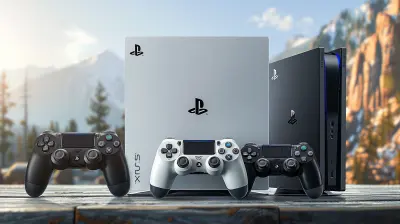Cloud Gaming: Is It Finally Ready to Go Mainstream?
13 June 2025
Ah, cloud gaming. The elusive unicorn of the gaming world. For years, it has been hyped as the future of gaming—you know, the thing that would save us all from the tyranny of overpriced consoles, endless updates, and storage issues. Yet, here we are in 2023, still scratching our collective heads and wondering: is cloud gaming really ready to take over, or is it just another tech buzzword that refuses to die? Spoiler alert: it’s complicated.
Let’s fire up the hype machine, plug into the sarcast-o-meter, and figure out if this so-called revolution is finally worth your time—or if it’s still just a pipe dream wrapped in a buffering icon.
What Even Is Cloud Gaming? (For Those Living Under a Rock)
If you’re new to the party, cloud gaming is a service where the actual processing of your games happens in a server farm somewhere in the ether (aka the "cloud"), while the visuals and gameplay stream to your device. Think Netflix, but with more lag and fewer “Are you still playing?” pop-ups. It promises to let you play high-end games on a potato laptop, a slightly broken tablet, or even your grandma’s ancient smart TV.Sounds magical, right? "Goodbye consoles, hello convenience!" Except, like all good things, there’s a catch or two (or ten). Let’s break it down.
The Tech Behind the Dream (Or Nightmare)
Cloud gaming relies on three major things: internet speed, server capacity, and black-magic-level compression. Essentially, these platforms (think Xbox Cloud Gaming, Nvidia GeForce Now, or Google Stadia… uh, RIP) stream the gameplay to you in real-time while your device sends back commands (like moving your character or pressing buttons). The smoother this conversation, the better the experience.But here’s the kicker: if your internet is more sluggish than a turtle on vacation, you can kiss your dream of seamless gameplay goodbye. Lag and latency are to cloud gaming what mosquitoes are to summer BBQs—they just won’t let you enjoy anything in peace.
Why Cloud Gaming Sounds Like a Dream Come True
Let’s be real—cloud gaming’s appeal is undeniable. It’s like a sales pitch straight from a genie:- No More Hardware Wars: Forget spending half your paycheck on the latest console or PC upgrades. With cloud gaming, you can theoretically play AAA titles on a device that’s as high-tech as a toaster.
- Instant Access: No downloads, no patches, no waiting for massive day-one updates. You see a game? Boom, you’re playing it in seconds. (Well, assuming your internet connection doesn’t call in sick.)
- Play Anywhere: Couch, bed, café, or bathroom—cloud gaming doesn’t care. As long as you have a Wi-Fi connection, you’re good to go. Just don’t blame me if your boss catches you playing “Cyberpunk 2077” during a Zoom meeting.
- Eco-Friendly Vibes: Gaming without the need for physical hardware might just help Mother Earth breathe a little easier. (That is, unless those server farms are secretly eating glaciers as a midnight snack.)
Why It Still Feels Like a Bad Internet Joke
As much as I’d love to call cloud gaming the savior of mankind, reality has a habit of intervening. Here’s why it often feels more like a beta test than a mainstream option:1. Internet Dependency (Cue the Facepalm)
Let’s address the elephant in the room: the internet. Cloud gaming basically says, “Hey, if your internet speed isn’t lightning-fast and super stable, too bad! You can’t sit with us.” Seriously, cloud gaming without good internet is like trying to win a Formula 1 race on a tricycle.In rural areas or countries with patchy connections, cloud gaming is about as reliable as your drunk uncle’s karaoke promises. And guess what? Even with great internet, you can still hit those dreaded buffering screens. Why? Because sometimes the cloud just feels like trolling.
2. Latency: The Gaming Equivalent of a Buzzkill
Ever tried playing a fast-paced shooter where your crosshairs show up two seconds after you move your mouse? Yeah, that’s latency for you. It’s the lag between pressing a button and seeing the action on the screen—and it’s the number one reason hardcore gamers laugh cloud gaming out of the room. In competitive gaming, milliseconds matter, and cloud gaming isn’t exactly known for, well, speed.3. The Quality Conundrum
Oh, you wanted 4K gaming with buttery smooth 60 FPS? That’s adorable. Unless you’re blessed with next-gen internet that costs as much as rent, expect to settle for compressed visuals and occasional pixelation. Watching your meticulously crafted game world turn into a watercolor painting mid-match? Priceless.4. Data Caps Are the Villains We Don’t Need
Fun fact: streaming games eats data like a college student eats instant noodles—nonstop. For folks stuck with ISP data caps, cloud gaming is basically a trap. Hit your limit, and enjoy either throttled speeds or an extra bill that’ll make you cry into your controller.5. The “Who Even Owns This Game?” Problem
With cloud gaming, you’re essentially renting games rather than owning them. Servers go down? Company shuts the service? Poof, your library vanishes faster than your New Year’s resolutions. Google Stadia’s closure was a harsh reminder of just how fragile this model can be.Is Anyone Actually Getting It Right?
Okay, so I’ve been a little harsh. (Hey, sarcasm is my love language.) But to be fair, some platforms are slowly ironing out the wrinkles. Nvidia GeForce Now gives you flexibility with your existing library, and Xbox Cloud Gaming is bundled with Game Pass, making it a tempting deal if you’re already Team Xbox.Sony’s PlayStation Plus also has a cloud component, and while it’s not perfect, it offers access to a decent library of classics and current-gen hits. Amazon Luna? Well, it’s... there. Let’s leave it at that.
The truth is, no one has quite nailed the formula yet. They’re close, but playing “Cyberpunk 2077” on the cloud still isn’t the same as firing it up on a high-end RTX PC. It’s the difference between flying first class and sticking your head out of a car window at 60 mph.
What Needs to Change?
For cloud gaming to truly go mainstream, a few things need to happen:1. Better Internet for All: ISPs, we’re looking at you. Until lightning-fast and consistent internet is a global standard (hello, Starlink?), cloud gaming will remain a niche at best.
2. Lower Latency: Tech companies need to find a way to cut down that lag. Maybe sacrifice a chicken to the network gods or something, I don’t know.
3. Affordable Pricing Models: Convincing people to pay for yet another subscription isn’t gonna be easy. Bundles like Xbox Game Pass are on the right track, but don’t expect the masses to go all-in just yet.
4. Game Library Ownership: Gamers like owning their games. It’s time to rethink those streaming licenses and maybe give people the option to at least buy or keep titles they love.
5. Trust in Services: After the Stadia debacle, trust in cloud gaming providers is shakier than a Jenga tower in an earthquake. Companies will need to prove they’re in this for the long haul.
The Verdict: Mainstream or Pipe Dream?
So, is cloud gaming finally ready to go mainstream? Well, kinda. The potential is definitely there, and the technology is improving. But just like your favorite RPG protagonist, it still has a lot of grinding to do before reaching its final form. For now, cloud gaming feels more like a quirky side quest than the main storyline.If you’ve got a blazing-fast internet connection and the patience to deal with the occasional hiccup, it’s worth a shot. For everyone else? Maybe wait until the cloud’s forecast looks a little sunnier.
all images in this post were generated using AI tools
Category:
Gaming NewsAuthor:

Tayla Warner
Discussion
rate this article
3 comments
Buzz McInnes
While cloud gaming shows promise, its success hinges on stable internet access and low latency. Until then, it may remain a niche solution for gamers.
June 17, 2025 at 4:36 AM

Tayla Warner
You make a valid point. Stable internet and low latency are crucial for cloud gaming's broader adoption. Until these issues are addressed, mainstream success may be limited.
Luna McGinn
While cloud gaming has made significant strides, issues like latency, bandwidth limitations, and game library availability still pose challenges. Its mainstream adoption depends on technological advancements and broader internet accessibility.
June 15, 2025 at 2:28 AM

Tayla Warner
You raise valid points. While cloud gaming is progressing, overcoming latency, bandwidth, and library challenges will be crucial for its mainstream success.
Ellie Adkins
Cloud gaming shows promise but still faces significant hurdles like latency issues, internet reliability, and game availability. While advancements are encouraging, it feels premature to declare it mainstream. Until infrastructure improves and a broader game library exists, traditional gaming remains the preferred choice for many.
June 14, 2025 at 2:46 AM

Tayla Warner
I appreciate your insights! You're right—while cloud gaming has potential, overcoming latency, reliability, and content challenges is essential for mainstream adoption. It's an evolving landscape, and improvements will play a crucial role in its future.



